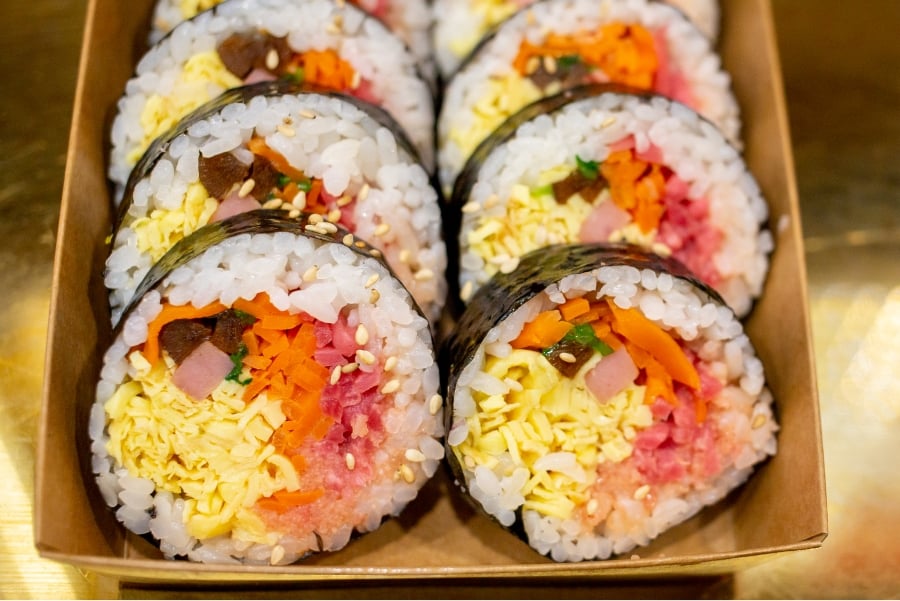Gimbap: Exploring the Evolving Flavors and Global Popularity of Korea’s Beloved Rice Rolls
Gimbap, a staple in Korean picnic lunches and a convenient daily meal option, has been steadily gaining popularity in overseas markets. Recently, imported frozen gimbap from Korea made waves in the United States, selling out within two weeks at the Trader Joe’s grocery chain and igniting considerable discussion. This article seeks to showcase the latest trends in gimbap, spotlighting its evolution beyond Korea and into the global culinary scene.
The Essence of Traditional Gimbap
Gimbap is a dish crafted by layering rice on laver (paper-thin seaweed), accompanied by vegetables like carrots and spinach, with ham, egg, and pickled radish, then tightly rolled and sliced into bite-sized pieces. While traditional gimbap remains a staple, recent variations have emerged, introducing new ingredients to expand its flavor palette.
Gimbap’s Global Popularity
Among the array of familiar foods for Koreans, gimbap has been steadily gaining popularity in overseas markets. Notably, imported frozen gimbap from Korea made waves in the United States, selling out within two weeks at the Trader Joe’s grocery chain and igniting considerable discussion.
Evolving Flavors and Trends
Recent variations of gimbap have introduced new ingredients to expand its flavor palette, catering to diverse tastes and preferences. As gimbap continues to captivate global audiences, its evolution within the culinary scene promises an exciting future for this beloved Korean dish.
Savory Pollack Roe Gimbap: A Busan Specialty Captivating Taste BudsIn recent years, the popularity of pollack roe has remained steady in Korea. Pollack roe, the eggs of pollack, has surged in popularity, featuring prominently in dishes such as pollack roe pasta, as well as avocado and pollack roe bibimbap, continuing the trend of dishes incorporating pollack roe. This trend has extended to Korean gimbap, where pollack roe has become a sought-after addition. Originating from Busan, pollack roe gimbap has recently captured attention as a unique variant, amassing a dedicated fan base drawn to its savory and rich taste. The key to crafting pollack roe gimbap lies in delicately layering rice on laver, incorporating various vegetables, layering it with salted pollack roe, and generously adding an egg garnish before rolling it. The mild yet flavorful egg garnish beautifully complements the saltiness of the pollack roe, enhancing the overall taste of the gimbap.
Aged Kimchi Gimbap: A Crunchy and Tangy Delight
What happens when gimbap meets a crispy texture with a tangy twist? Aged for over 6 months at low temperatures, aged kimchi offers a delightful tanginess. In the form of aged kimchi gimbap, this ingredient brings both texture and taste, delivering a unique flavor experience. Particularly favored are the aged kimchi and tuna gimbap, which feature thinly layered rice on laver, incorporating assorted vegetables, egg garnish, aged kimchi, and tuna. The aged kimchi, rinsed of its red seasoning and gently squeezed of moisture, is then combined with sesame oil and sugar to unveil its rich flavor profile. The crunchy aged kimchi intertwines with the savory tuna, offering a diverse and flavorful sensation in every bite. Accompanying the aged kimchi and tuna gimbap, the pork belly gimbap has also emerged as a distinctive favorite. Encased within are vegetables for wraps, a mixed paste, and pork belly, delivering an experience reminiscent of indulging in leaf wraps at a pork belly restaurant. This gimbap offers a hearty and deeply satisfying meal option.
Personalized Gimbap: Customizing Your Culinary Adventure
Customizable gimbap has emerged, allowing customers to select their preferred ingredients via a kiosk. With options to select rice type, vegetables, toppings, and sauces, visitors can customize their gimbap orders. The preparation unfolds before visitors’ eyes through transparent counters, highlighting the crafting of personalized gimbap using fresh, quality ingredients. Moreover, an assortment of dipping sauces offers a diverse range of flavors, elevating the overall gimbap experience. Adored for its creamy and savory tuna mayonnaise filling, the tuna and mayonnaise gimbap charms with its universally appealing taste. Adding a fragrant basil sauce elevates this gimbap, imparting an aromatic basil essence that enriches its flavor profile. On the other hand, the tomato pork gimbap, showcasing a delightful blend of sweet-sour tomato sauce and pork, pairs exceptionally well with a flavorful aioli sauce.
Buckwheat Gimbap: A Nutritious and Delectable Alternative
Alternate versions of gimbap without rice are gaining considerable popularity. Buckwheat gimbap, substituting rice with buckwheat noodles, has emerged as a sought-after choice due to its reduced carbohydrate content compared to traditional rice-based gimbap. The soft texture and nutty, subtle flavor of buckwheat noodles set it apart from the usual gimbap. Additionally, the inclusion of generous portions of rolled omelettes not only augments the protein content but also complements the gentle, sweet essence of buckwheat. Buckwheat gimbap with deep-fried shrimp is adored for its seamless harmony, blending the savory richness of the crispy, oily deep-fried shrimp with the delicate nature of buckwheat. Modern adaptations of gimbap showcase reduced rice content or replacing with alternative ingredients, emphasizing higher proportions of eggs, vegetables, and a wider array of nutrients. Among these innovations, buckwheat gimbap stands out, leveraging the nutritional prowess of the superfood buckwheat. Not only does it marry health benefits with flavor, but it also serves as a low-calorie alternative, catering to those following a diet-conscious approach.
From the classic pollack roe gimbap to the innovative buckwheat gimbap, the world of Korean gimbap continues to evolve, offering a diverse array of flavors and textures to delight the senses. Whether you’re a seasoned gimbap enthusiast or a newcomer to this culinary delight, there’s a gimbap experience waiting to be discovered in the vibrant food scene of Korea.




